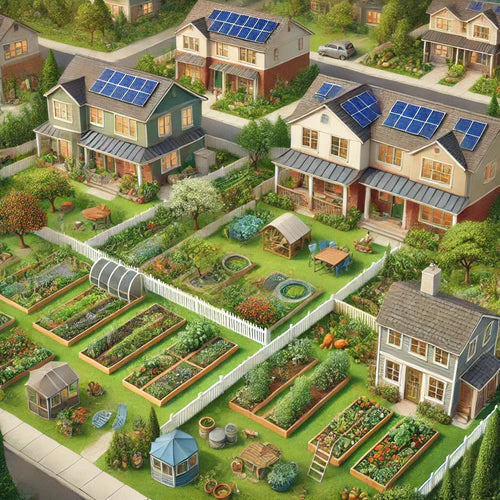The Garden is Here; We Just Don’t Know It Yet
Urban gardening is not just about planting seeds but nurturing a thriving ecosystem within our cities. The steps below complements The Call to Grow and is inspired by The Gardener's Art of War. It will guide you through the year, instilling strategies that align with the changing seasons and empower communities to become sustainable food sources. Each month, we move forward collectively, laying the groundwork for a resilient urban landscape. Let this be the beginning of a lifelong journey toward nurturing our cities back to their roots.

- Answer The Call for early access to updates and resources such as this planner. -
**Inspirational Gem** We Found America's Lost Food Forest - Andrew Millison 2025![]()
Which Seed will you chose today?
January – "Laying Plans"
Step 1: Strategize and Prepare
- Assess community needs and plot out shared garden spaces.
- Begin soil preparation and composting plans.
-
Engage local volunteers to plan infrastructure and support.
🌱 Planting: Start seeds for hardy greens like kale and spinach indoors.
🔧 Operational: Test soil health and start composting kitchen scraps.
🤝 Sharing: Distribute soil test kits or host a composting workshop.
💡 Tip: Plan your garden layout, including crop rotations for the year.
The Gardeners Art of War - Quote of the Month
"A garden is a grand teacher. It teaches patience and careful watchfulness; it teaches industry and thrift; above all it teaches entire trust": Trust the process and be patient with the growth of your garden."
February – "Waging War"
Step 2: Prepare for the Challenges Ahead
- Identify potential threats such as weather variability and pests.
- Implement early pest prevention measures.
- Equip community members with organic pesticide options.
🌱 Planting: Sow lettuce and broccoli indoors; build cold frames for frost protection.
🔧 Operational: Clear old plant debris to prevent pests.
🤝 Sharing: Organize a seed-swap event to share resources.
💡 Tip: Prune fruit trees like figs and jujube for optimal growth.
The Gardeners Art of War - Quote of the Month
"The art of gardening is a battle, and the wise gardener must be prepared to face their enemies. Time, neglect, pestilence, drought, soil depletion, unpredictable weather, and a fickle market are all adversaries that threaten to defeat the gardener's efforts. But with strategy, determination, and the ability to adapt, the gardener can emerge victorious."
March – "Attack by Stratagem"
Step 3: Tactics for Early Growth
- Begin planting cool-season crops with strategic spacing.
- Establish a rotation plan that ensures soil health.
- Foster collaboration through seed-sharing events.
🌱 Planting: Transplant cool-season crops and sow carrots and radishes.
🔧 Operational: Mulch and set up rain barrels for water conservation.
🤝 Sharing: Host a community planting day.
💡 Tip: Inspect plants early for signs of pests.
The Gardeners Art of War - Quote of the Month
"The Strategem of Diligence" - In order to combat neglect, the wise gardener must learn to be consistent and persistent in their efforts. This can be achieved by setting daily, weekly, and monthly routines for tending to the land, and by regularly monitoring the health and progress of the crops."
April – "Tactical Dispositions"
Step 4: Build Infrastructure
- Construct raised beds and irrigation systems for better garden management.
- Map out plots for optimal sun and water exposure.
- Engage local builders for community-focused garden structures.
🌱 Planting: Start warm-season crops like tomatoes, peppers, and herbs.
🔧 Operational: Install drip irrigation for efficient watering.
🤝 Sharing: Teach neighbors about irrigation techniques.
💡 Tip: Track planting dates in a garden journal.
The Gardeners Art of War - Quote of the Month
"The wise gardener must be a master of courage, for the art of the march is the art of facing fear. The wise gardener must be willing to take risks and face their fears, for a march without courage is a march to defeat."
May – "Energy"
Step 5: Harness the Power of Engagement
- Organize community gardening days to maintain momentum.
- Involve local schools and organizations in gardening workshops.
- Develop mental and physical strategies to sustain enthusiasm.
🌱 Planting: Add companion flowers like marigolds to attract pollinators.
🔧 Operational: Maintain garden tools for peak performance.
🤝 Sharing: Share extra seedlings with friends or a food pantry.
💡 Tip: Harvest early crops to make space for new plantings.
The Gardeners Art of War - Quote of the Month
". . . And the energy of the self must be nurtured through self-care, proper nutrition and physical activity, and a positive mindset."
June – "Weak Points and Strong"
Step 6: Identify Strengths and Weaknesses
- Assess the soil and crop conditions; adjust fertilization plans as needed.
- Hold training sessions on sustainable watering practices.
- Evaluate volunteer and resource contributions for areas of improvement.
🌱 Planting: Grow heat-tolerant crops like okra and sweet potatoes.
🔧 Operational: Monitor moisture levels and apply mulch.
🤝 Sharing: Set up a garden buddy system with neighbors.
💡 Tip: Add compost to boost nutrient-deficient areas.
The Gardeners Art of War - Quote of the Month
The 7 Judges await you.
July – "Maneuvering"
Step 7: Adapt and Rotate
- Introduce crop rotation to maximize yield and maintain soil health.
- Implement adaptive planting techniques for weather changes.
- Diversify crops to meet the community’s nutritional needs.
🌱 Planting: Begin fall crops like pumpkins and squash.
🔧 Operational: Prune for better air circulation.
🤝 Sharing: Celebrate progress with a garden party.
💡 Tip: Use shade cloths to protect delicate plants from heat.
The Gardeners Art of War - Quote of the Month
To remain stagnant in crop rotation is to invite defeat. The wise gardener must constantly evaluate their land and adapt their strategies accordingly, for the land is a living, breathing entity.
August – "Variation in Tactics"
Step 8: Innovate and Experiment
- Experiment with new planting techniques like vertical gardening and hydroponics.
- Initiate workshops on companion planting for better pest control.
- Share success stories within the community to inspire creative approaches.
🌱 Planting: Sow spinach, radishes, and kale for fall harvests.
🔧 Operational: Focus on pest control and weed management.
🤝 Sharing: Donate extra produce to food banks.
💡 Tip: Try vertical gardening to maximize limited space.
The Gardeners Art of War - Quote of the Month
"The variation of crop companion planting is a tactic of the wise gardener, for pairing certain plants together can lead to increased pest and disease resistance, leading to a more sustainable food source for the family."
September – "The Army on the March"
Step 9: Expand Your Reach
- Transport excess produce to farmers markets and local food drives.
- Set up pop-up farm stands to engage local residents.
- Build partnerships with local grocers for direct-to-market sales.
🌱 Planting: Start cover crops to enrich the soil for next year.
🔧 Operational: Preserve summer harvests through canning or drying.
🤝 Sharing: Partner with schools for youth gardening programs.
💡 Tip: Evaluate your garden layout for next year’s improvements.
The Gardeners Art of War - Quote of the Month
"The Community Army" - This army is made up of local community members who come together to grow food in shared spaces such as community gardens and rooftop gardens."
October – "Terrain"
Step 10: Understand Your Environment
- Assess the changing landscape and adapt planting techniques accordingly.
- Conduct soil tests and adjust composting methods as the seasons shift.
- Plan for winter crops or cover crops to maintain soil vitality.
🌱 Planting: Garlic and shallots are perfect for fall.
🔧 Operational: Collect leaves for compost and mulch.
🤝 Sharing: Organize a neighborhood cleanup to prepare for winter.
💡 Tip: Research new plant varieties for your zone.
The Gardeners Art of War - Quote of the Month
"As a gardener, it is essential to understand the terrain in which you will be working. Each type of terrain presents its own set of opportunities and challenges, and by understanding them, you can make informed decisions on how to care for your plants."
November – "The Nine Situations"
Step 11: Sharing and Supporting
- Organize seed exchange events with local community centers and places of worship.
- Adopt a daycare or school garden for next season’s growth.
- Share knowledge and resources to inspire new participants to join.
🌱 Planting: Save seeds from this year’s crops for the next planting.
🔧 Operational: Prune dormant perennials and fruit trees.
🤝 Sharing: Adopt a daycare for seed distribution.
💡 Tip: Reflect on your garden’s successes and challenges.
The Gardeners Art of War - Quote of the Month
"Pest and Disease Infestation - The Silent Invaders
Just as an army faces unseen adversaries, a gardener confronts the hidden threat of pests and diseases that can ravage plants and thwart growth. To counter this, a gardener must be vigilant and proactive. Regular inspection, proper sanitation, and the use of companion planting techniques can serve as the garden's defense. By employing integrated pest management strategies and nurturing a healthy ecosystem, the gardener can stave off these relentless foes."
December – "The Attack by Fire" & "The Use of Spies"
Step 12: Embrace Technology and Reflect
- Utilize tech tools to monitor and analyze garden health over the year.
- Prepare winter maintenance plans, including flame weeding and soil solarization.
- Reflect on the year’s lessons and gather data to enhance next season’s growth.
🌱 Planting: Plan new planting strategies and layouts.
🔧 Operational: Organize tools and finalize composting systems.
🤝 Sharing: Share gardening books and knowledge with friends.
💡 Tip: Use apps to map out next year’s garden for better yields.
The Gardeners Art of War - Quote of the Month
"Cooperative Extension Services and Agtech companies are great resources for growers to stay updated on the latest technologies and best practices in sustainable agriculture; similar to a mentor who keeps the commander informed wisely, prioritized responsibly, and ready for the challenges ahead."
Call to Action: Let's Seed Tomorrow Today
🌟 Can you see the abundance yet? Let’s build it one seed at a time.
💻 Check out our Leafcycle Calendar for workshops, planting days, and local events to grow your skills and impact in 2025.
🌿 Happy Growing!
#UrbanGardening #SustainableLiving #PlantAndShare #FoodForestDFW #RedefineLocal #BragaFarmsDFW #GardeningJourney #SeedToHarvest #ThrivingCommunities
Stay Connected with the Growing Revolution 🌱
Have questions or want to dive deeper into sustainable farming and urban homesteading?
Connect with us for resources, updates, and exclusive tips to transform your land into a sustainable powerhouse.
- 🌐 Visit our website: BragaFarmsDFW.com
- 📧 Contact us: bragafarms@outlook.com
- 📱 Follow us on TikTok: @BragaFarmsDFWtx
- 📸 Follow us on Instagram: @BragaFarmsDFW
- 📖 Explore our Amazon Gardening Collection: Shop Now
Visit Braga Farms
📍 Location: 123 Taylor St, Dallas, TX 75201
🛒 When to find us: Saturdays and Sundays at the Dallas Farmers Market
📅 Plan your visit: Check out our Leafcycle calendar
Join the Movement 🌎
Be part of a community that’s revolutionizing local food systems and creating sustainable solutions for the future.
- 📘 Read The Gardener’s Art of War: Learn More
- 🎥 Take a Virtual Tour: Front Yard Figs 2021
- 📝 Subscribe to our blog for weekly insights.
- 🤝 Share your journey with us using #BragaFarmsDFW.
- 🎓 Check out our workshops and consulting services: Learn More
Celebrating 1,500+ ⭐⭐⭐⭐⭐ Google Reviews!
📍 Check out our Google Profile: Click Here
📍 Support and pay us here: Click Here

